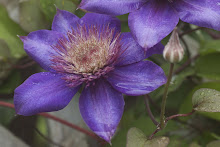At a friend's house recently, I noticed
some early signs that fall is just around the corner.
This is one of the last columbine blossoms . . .
The woodpile is growing,
and the resident chipmunk is gathering
his winter stores by the mouthful . . .
 Odiorne Point State Park is the last undeveloped section of shoreline in New Hampshire, is the site of the first New Hampshire settlement in 1623, and served an important military role during World War II. The salt marsh area was very important for the early settlers, who harvested the marsh hay every year. And the area was also part of the Portsmouth harbor defense during World War II; the camouflaged concrete gun casements and gun mounts are still visible.
Odiorne Point State Park is the last undeveloped section of shoreline in New Hampshire, is the site of the first New Hampshire settlement in 1623, and served an important military role during World War II. The salt marsh area was very important for the early settlers, who harvested the marsh hay every year. And the area was also part of the Portsmouth harbor defense during World War II; the camouflaged concrete gun casements and gun mounts are still visible. But the varied natural habitats of Odiorne Point were the primary focus of our trip on Monday -- the salt marsh, the estuaries, and the rocky shore. The students recorded water temperatures and water density; they collected and examined organisms with a seine net (and, of course, returned all the organisms to the water).
But the varied natural habitats of Odiorne Point were the primary focus of our trip on Monday -- the salt marsh, the estuaries, and the rocky shore. The students recorded water temperatures and water density; they collected and examined organisms with a seine net (and, of course, returned all the organisms to the water).
 The day was a lot of fun and the weather was perfect. Hats off to all the students, who were prepared and worked well together. And hats off to the hard-working teachers and aides who plan and run this valuable hands-on educational experience!!
The day was a lot of fun and the weather was perfect. Hats off to all the students, who were prepared and worked well together. And hats off to the hard-working teachers and aides who plan and run this valuable hands-on educational experience!!






 While I've had a few white-breasted nuthatches all winter, I've suddenly been getting a lot of the smaller red-breasted nuthatches. They do a fast grab and run at the sunflower chips, but stay much longer on the suet feeder. As fast as they are, they've been easier to get photos of than the larger white-breasted nuthatch.
While I've had a few white-breasted nuthatches all winter, I've suddenly been getting a lot of the smaller red-breasted nuthatches. They do a fast grab and run at the sunflower chips, but stay much longer on the suet feeder. As fast as they are, they've been easier to get photos of than the larger white-breasted nuthatch.
 This winter I've also added a few "firsts" to my bird life list. About three weeks ago I had a white-winged crossbill under my feeders. Yesterday, I had a LBJ (little brown jobby) with reddish chest up in the tree watching me for quite awhile. But it wasn't the usual house finch or purple finch. First I had a male common redpoll, then later a female staring at me from the branch.
This winter I've also added a few "firsts" to my bird life list. About three weeks ago I had a white-winged crossbill under my feeders. Yesterday, I had a LBJ (little brown jobby) with reddish chest up in the tree watching me for quite awhile. But it wasn't the usual house finch or purple finch. First I had a male common redpoll, then later a female staring at me from the branch. So, while winter probably hasn't had its last hurrah, signs of spring are here.
So, while winter probably hasn't had its last hurrah, signs of spring are here.
 It was a cold February morning -- the skies were beginning to brighten, but the cold had left a thin layer of frost on all the bare branches along the lakes.
It was a cold February morning -- the skies were beginning to brighten, but the cold had left a thin layer of frost on all the bare branches along the lakes.

